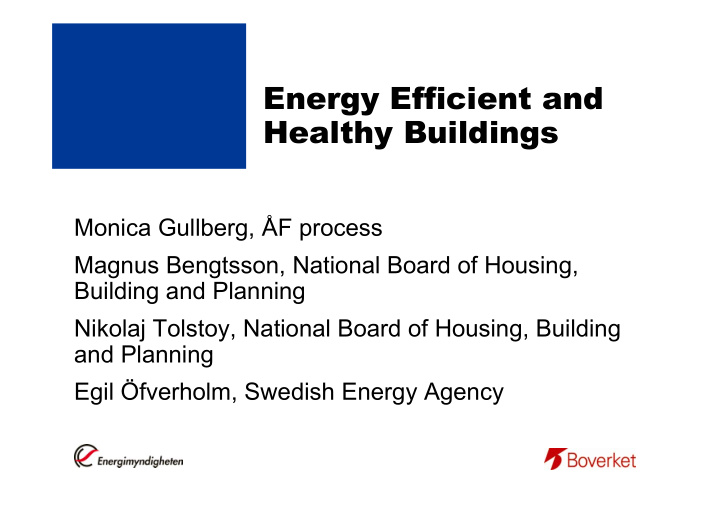



Energy Efficient and Healthy Buildings Monica Gullberg, ÅF process Magnus Bengtsson, National Board of Housing, Building and Planning Nikolaj Tolstoy, National Board of Housing, Building and Planning Egil Öfverholm, Swedish Energy Agency
Purpose - energy • Evaluate existing measures • Find new efficient measures • Survey energy demand and find efficiency potentials • Make better forecasts for energy demand and CO2 emissions • Develope basic data for the buildings performance directive • Information activities on energy efficiency in buildings • etc…
Electricity demand - Schools Miscellaneous; 5,28 Other appliances; 2 ; Fans; 18,04kWh/m 2 ; 5% kWh/m 2 ; 4% 3,76kWh/m 19% Kitchen; 2 ; 11% 10,81kWh/m Computerhall & Cooling machines; 2 ; server; 0,10kWh/m 2 ; 0% 0,04kWh/m 0% 2 ; 1% PC; 1,43kWh/m Lighting; 2 ; 21% 19,80kWh/m Electric heating; 2 ; 37% 34,76kWh/m Other building installations; 2 ; 3% 3,21kWh/m Heat pumps 2 ; 1% 1,26 kWh/m
Electricity demand 350 [kWh/m 2 , year] Miscellaneous, others 300 Apparatus, miscellaneous Building installations, miscellaneous Refrigeration PCs 250 Large computer/servers Fans Lighting 200 150 100 50 0
Lighting, annual specific electricity [kWh/m 2 ], distribution and mean. 60 [kWh/m 2 , year] 50 40 30 20 10 0
Energyefficiency possibilities - ventilation
Energyefficiency possibilities - ventilation Operation h. 8,2 kWh/m2 SFP 2,9 kWh/m2 Air changes 9,2 kWh/m2
Purpose of the environment survey – Enable follow up of the in-door environment in comparison to the building regulations – Search for a connection between energy use and in-door environment – Gain experience for similar future studies that are under way
Indoor environment in STIL-2 • Survey • Questionnaires' • Long-term measurements – Radon – Temperature, indoor and out – Relativ humidity, indoor and out
Indoor environment, eight gradings of the technical status – Magnetic fields – Lighting – Legionaries decease – Sound – Moisture – Air quality – Thermal environment – Cleaning efficiency
Questionnaires – Personal data – Working environment – Working conditions – illness/ailments – School environment
Result indoor environment Average grading for each school, average 3,33; weighted national average 3,88 4,50 4,00 3,50 3,00 Medelbetyg 2,50 2,00 1,50 1,00 0,50 0,00
Result indoor environment
Result questionnaire
Pearson correlation analysis User response Audit Indoor climate Audit energy Thermal Climate Thermal Air Climate U-value, average Air Quality Air Quality SFP+airflow + op. hours Noise Noise Window area Complaints Lighting Lighting Average score Total energy Pupils Teachers/employees Pupils/teachers Area/pupil Building, year + installation year
Pearson correlation analysis User response Audit Indoor climate Audit energy Thermal Climate Thermal Air Climate U-value, average Air Quality Air Quality SFP+airflow + op. hours Noise Noise Window area Complaints Lighting Lighting Average score Total energy Pupils Teachers/employees Pupils/teachers Area/pupil Building, year + installation year
Pearson correlation analysis User response Audit Indoor climate Audit energy Thermal Climate Thermal Air Climate U-value, average Air Quality Air Quality SFP+airflow + op. hours Noise Noise Window area Complaints Lighting Lighting Average score Total energy Pupils Teachers/employees Pupils/teachers Area/pupil Building, year + installation year
Pearson correlation analysis User response Audit Indoor climate Audit energy Thermal Climate Thermal Air Climate U-value, average Air Quality Air Quality SFP+airflow + op. hours Noise Noise Window area Complaints Lighting quality Lighting, kWh/m 2 Average score Total energy Pupils Teachers/employees Pupils/teachers Area/pupil Building, year + installation year
Pearson correlation analysis User response Audit Indoor climate Audit energy Thermal Climate Thermal Air Climate U-value, average Air Quality Air Quality SFP+airflow + op. hours Noise Noise Window area Complaints Lighting quality Lighting, kWh/m 2 Average score Total energy Pupils Teachers/employees Pupils/teachers Area/pupil Building, year + installation year
No contradiction between good indoor environment and energy efficiency
More info can be found at: www.energimyndigheten.se
Recommend
More recommend